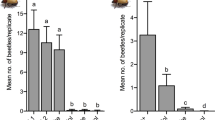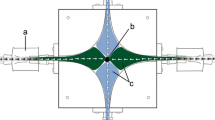Abstract
Male white-spotted longicorn beetles Anoplophora malasiaca raised on willow Salix schwerinii were preferentially attracted to the odour of wounded S. schwerinii branches when released near a female model in the laboratory. This attractiveness rapidly decreased within 2 h after wounding. Solid phase microextraction and subsequent gas chromatography analyses of volatiles from the wounded branches detected three highly volatile monoterpenes: 1,8-cineole, nerol and geraniol. Among the monoterpene compounds, nerol showed a significant attractiveness to the male beetles raised on Salix. Sesquiterpene hydrocarbons, which have been identified as attractants for a beetle population raised on citrus, were detected only in trace amounts in S. schwerinii branches. These results suggest that beetles raised on these two hosts use different odour cues for mate location.







Similar content being viewed by others
References
Adachi I, Korenaga R, Arai T (1992) Movement patterns of Anoplophora malasiaca (Thomson) (Coleoptera: Cerambycidae) adults within a citrus tree. Bull Fruit Tree Res Stn 23:179–191
Akino T, Fukaya M, Yasui H, Wakamura S (2001) Sexual dimorphism in cuticular hydrocarbons of the white-spotted longicorn beetle, Anoplophora malasiaca (Coleoptera: Cerambycidae). Entomol Sci 4:271–277
Alison JD, Borden JH, Seybold SJ (2004) A review of the chemical ecology of the Cerambycidae (Coleoptera). Chemoecology 14:123–150
Fan J, Kang L, Sun J (2007) Role of host volatiles in mate location by the Japanese pine sawyer Monochamus alternatus Hope (Coleoptera: Cerambycidae). Environ Entomol 36:58–63
Fukaya M, Akino T, Yasuda T, Wakamura S, Satoda S, Senda S (2000) Hydrocarbon components in contact sex pheromone of the white-spotted longicorn beetle, Anoplophora malasiaca (Thomson) (Coleoptera: Cerambycidae) and pheromonal activity of synthetic hydrocarbons. Entomol Sci 3:211–218
Fukaya M, Akino T, Yasuda T, Yasui H, Wakamura S (2004) Visual and olfactory cues for mate orientation behaviour in male white-spotted longicorn beetle, Anoplophora malasiaca. Entomol Exp Appl 111:111–115
Fukaya M, Akino T, Yasui H, Yasuda T, Wakamura S, Yamamura K (2005a) Effect of size and color of female models for male mate orientation in the white-spotted longicorn beetle Anoplophora malasiaca (Coleoptera: Cerambycidae). Appl Entomol Zool 40:513–519
Fukaya M, Yasui H, Yasuda T, Akino T, Wakamura S (2005b) Female orientation to the male in the white-spotted longicorn beetle, Anoplophora malasiaca by visual and olfactory cues. Appl Entomol Zool 40:63–68
Hanks LM (1999) Influence of the larval host plant on reproductive strategies of cerambycid beetles. Annu Rev Entomol 44:483–505
Kojima K, Nakamura S (1986) Food plants of cerambycid beetles (Cerambydae, Coleoptera) in Japan. Hiba Society of Natural History Press, Hiroshima
Landolt PJ, Phillips TW (1997) Host plant influences on sex pheromone behavior of phytophagous insects. Annu Rev Entomol 42:371–391
Miller DR (2007) Limonene: attractant kairomones for white pine corn beetles (Coleoptera: Scolytidae) in an eastern white pine seed orchard in western North Carolina. J Econ Entomol 100:815–822
Ohbayashi N (1992) Genus Anoplophora Hope, 1839. In: An Illustrated Guide to Identification of Longicorn Beetles of Japan (in Japanese). (Ohbayashi N, Satô M, Kojima K eds.). Tokai University Press, Tokyo, pp 583–584
Silk PJ, Sweeney J, Wu J, Price J, Gutowski JM, Kettela EG (2007) Evidence for a male-produced pheromone in Tetropium fuscom (F.) and Tetropium cinnamopterum (Kirby) (Coleoptera; Cerambycidae). Naturwissenschaften 94:697–701
Sokal RR, Rohlf FJ (1995) Biometry, the principles and practice of statistics in biological research, 3rd edn. W. H. Freeman and Company, New York
Yasui H (2009) Chemical communication in mate location and recognition in the white-spotted longicorn beetle, Anoplophora malasiaca (Coleoptera: Cerambycidae). Appl Entomol Zool 44:183–194
Yasui H, Yasuda T, Fukaya M, Akino T, Wakamura S, Hirai Y, Kawasaki K, Ono H, Narahara M, Kousa K, Fukuda T (2007) Host plant chemicals serve intraspecific communication in the white-spotted longicorn beetle, Anoplophora malasiaca (Thomson) (Coleoptera: Cerambycidae). Appl Entomol Zool 42:255–268
Yasui H, Akino T, Fukaya M, Wakamura S, Ono H (2008) Sesquiterpene hydrocarbons: kairomones with a releaser effect in the sexual communication of the white-spotted longicorn beetle, Anoplophora malasiaca (Thomson) (Coleoptera: Cerambycidae). Chemoecology 18:233–242
Acknowledgments
We thank Taeko Maeda and Ikuko Hashimoto of the NIAS and Takahiro Ogai of Tsukuba University for assistance with the experiments and rearing of the insects; Sumie Shimizu of NIAS is also thanked for rearing the insects. Thanks are also due to Kenjiro Kawasaki of the NIAS and Yasue Yaginuma of Ryozen-Tensan-no-kai for collecting the insects and to Toshimasa Mitamura of Fukushima Agricultural Technology Centre for providing S. schwerinii branches. Special thanks are due to Seiji Tanaka, Kotaro Maeno and Ken-ichi Harano for invaluable discussions and critical comments. We also thank Shinobu Akiyama of the National Museum of Nature and Science for stating the scientific name of the Salix species. Improvement of the manuscript by Serge Glushkoff is appreciated.
Author information
Authors and Affiliations
Corresponding author
Additional information
H. Yasui, N. Fujiwara-Tsujii and S. Wakamura contributed equally to this article.
Rights and permissions
About this article
Cite this article
Yasui, H., Fujiwara-Tsujii, N. & Wakamura, S. Volatile attractant phytochemicals for a population of white-spotted longicorn beetles Anoplophora malasiaca (Thomson) (Coleoptera: Cerambycidae) fed on willow differ from attractants for a population fed on citrus. Chemoecology 21, 51–58 (2011). https://doi.org/10.1007/s00049-010-0065-z
Received:
Accepted:
Published:
Issue Date:
DOI: https://doi.org/10.1007/s00049-010-0065-z




